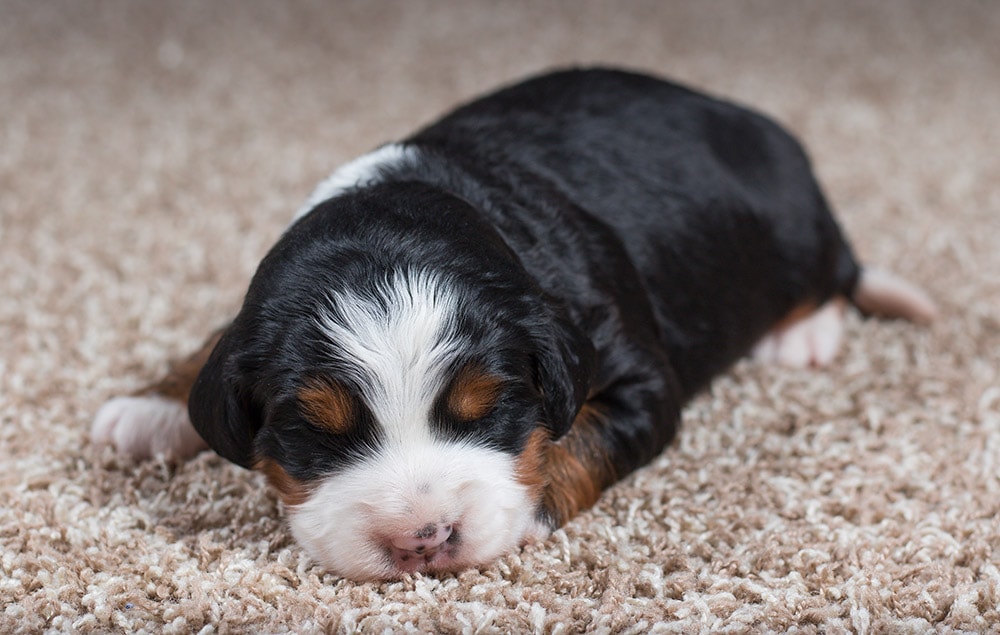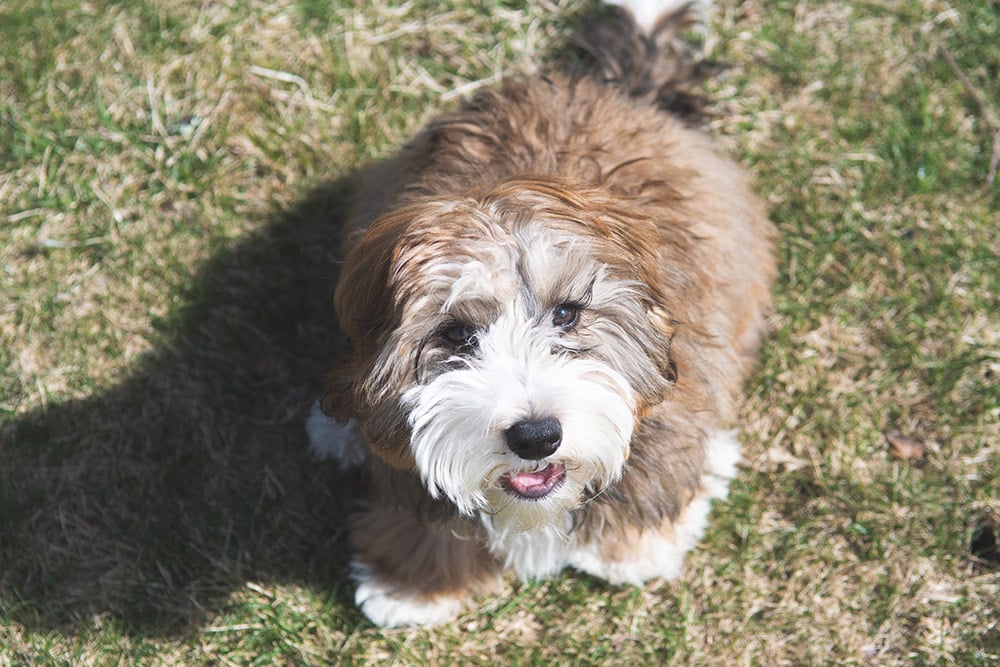Click Below to Skip Ahead
The Mini Bernedoodle is a hybrid breed combining the best features of two loved breeds—Miniature Poodles and Bernese Mountain Dogs. One common question that potential Mini Bernedoodle owners often ask is how big these dogs will get.
Knowing their growth pattern can help in planning for their housing needs, exercise requirements, and understanding their overall health status. This article aims to shed light on the size and growth pattern of Mini Bernedoodles.
Mini Bernedoodle Breed Overview
Mini Bernedoodles are a relatively new breed, bred for their intelligence, companionship, and hypoallergenic qualities. A Miniature Poodle’s cleverness and a Bernese Mountain Dog’s loyalty and affability make the Mini Bernedoodle a charming and bright breed that fits well into many households. This breed is also known for its playful energy, making them a great choice for active families.
The size of a Mini Bernedoodle can vary, largely dependent on the parents’ size. Generally, these dogs range from 18 to 22 inches in height and can weigh anywhere between 25 to 50 pounds when fully grown. Due to their manageable size, they are often suitable for both apartment living and larger homes.

Mini Bernedoodle Size and Growth Chart
It’s crucial to remember that there can be considerable variations in the size of Mini Bernedoodles, even within the same litter. However, the chart below provides a rough estimate of what you might expect in terms of their growth and size.
| Age | Weight Range | Length Range |
| Newborn (0–1 month) | 1–2 pounds | 3–4 inches |
| 2 months | 6–8 pounds | 6–8 inches |
| 4 months | 12–16 pounds | 9–12 inches |
| 6 months | 18–22 pounds | 12–15 inches |
| 8 months | 23–30 pounds | 14–17 inches |
| 12 months | 25–40 pounds | 16–20 inches |
| 14 months | 25–50 pounds | 18–22 inches |

When Does a Mini Bernedoodle Stop Growing?
Mini Bernedoodles usually stop growing in height around 11 to 12 months of age. After reaching their maximum height, they will continue to fill out, gaining muscle mass and a bit more weight until they’re about 14 to 16 months old.
However, it’s important to note that these timelines aren’t set in stone and can vary with each dog. Factors such as genetics, diet, and overall health will play significant roles in a Mini Bernedoodle’s growth and development.

Factors Affecting the Size of Mini Bernedoodles
The size of a Mini Bernedoodle is determined by several factors:
Genetics
Genetics plays a significant role in determining a Mini Bernedoodle’s size. If the parents are larger or smaller for their breed, the puppies are likely to follow suit.
Breeders often aim to pair dogs that will produce puppies of the desired size, but genetics can be unpredictable, and variations do occur.
Nutrition
Proper nutrition is a linchpin for healthy growth. Feeding your Mini Bernedoodle a balanced diet from puppyhood is essential to ensure they reach their full potential. Overfeeding, on the other hand, can lead to obesity, which can stunt growth and lead to other health issues.
It’s crucial to follow feeding guidelines and adapt them to your pet’s specific needs, considering factors like activity level and age.
Exercise
Regular and appropriate exercise is essential for a Mini Bernedoodle’s healthy development. Not only does physical activity promote cardiovascular health and muscle development, but it also plays a significant role in maintaining an ideal weight. A sedentary lifestyle can lead to obesity, adversely affecting the dog’s size and overall health.
It’s important to remember that while exercise is crucial, puppies should not be over-exercised, as their bones and joints are still developing.

Ideal Diet for Maintaining a Healthy Weight
Providing your Mini Bernedoodle with a balanced diet is crucial for maintaining a healthy weight and promoting optimal growth. Here’s what an ideal diet should include:
Proteins
As the building block of cells, proteins are vital for the growth, maintenance, and repair of body tissues. High-quality, easily digestible animal proteins such as chicken, beef, fish, and lamb should form the bulk of your Mini Bernedoodle’s diet.
Carbohydrates
Carbohydrates provide your dog with energy and should be included in moderation. Complex carbs, like sweet potatoes, brown rice, and oats, are preferred due to their nutritional value and slow-release energy.
Fats
Fats are not only a concentrated source of energy but also vital for brain development and maintaining a healthy coat and skin. Look for foods rich in beneficial fats, such as omega-3 and omega-6 fatty acids.
Fiber, Vitamins, and Minerals
These are essential for maintaining digestive health, promoting a robust immune system, and supporting overall well-being. They can be found in fruits, vegetables, grains, and certain dog-friendly superfoods.
High-quality commercial dog foods, particularly those designed for small to medium-breed puppies and adults, can meet the nutritional needs of Mini Bernedoodles.
Remember to adjust portions according to your pet’s size, age, and activity level to prevent overfeeding and obesity. Regular consultations with your vet can help you tailor the most appropriate diet plan for your pet.

How to Measure Your Mini Bernedoodle
Keeping track of your Mini Bernedoodle’s size involves regularly monitoring its height and weight. If you’re uncomfortable measuring your dog or just have a difficult time doing it, your vet can always do it for you. If you’re ready to give it a try, here’s what you need to know:
Height
To measure your dog’s height, make sure they’re standing on a flat surface. Measure from the ground to the top of their shoulders (the highest point of the withers), not the top of their head.
Weight
A pet or veterinary scale is the most accurate tool for weighing your Mini Bernedoodle. Ensure your pet is calm and still for an accurate reading.
Regular measurements can help you track your Bernedoodle’s growth and ensure they are maintaining a healthy weight. Any sudden changes in weight or growth should be discussed with a veterinarian to rule out potential health issues.
Conclusion
Knowing how big your Mini Bernedoodle might get can be helpful for both prospective and new owners. Understanding your pet’s growth chart aids in anticipating their future needs, from diet adjustments to exercise routines. With proper care, balanced nutrition, and a loving environment, your Mini Bernedoodle will grow into a healthy and loyal companion.
Featured Image Credit: Georgi Baird, Shutterstock












